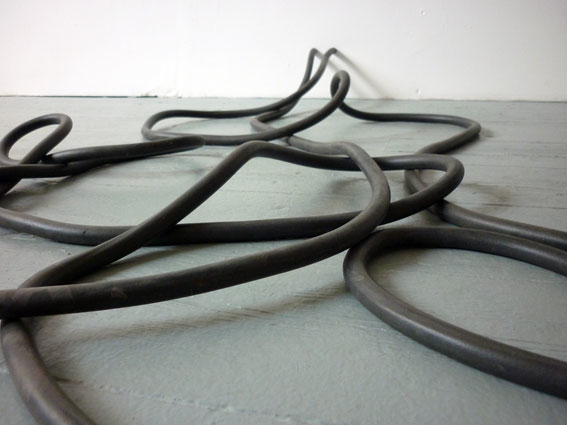


Artists: Jeremy Evans, Jörg Köppl, Emily Speed, Jill Townsley, Yonatan Vinitsky, Joby Williamson, Ben Woodeson
April 6 until April 15, 2011
Frederic Parker Gallery, London, The United Kingdom
Curated in collaboration with the MA 'Curating the Contemporary', taught jointly between the London Metropolitan University and the Whitechapel Gallery.
The artists presented in Textures of Time share a common interest in making temporalities tangible. Taking temporality as its point of departure the artworks become agents in order to scrutinize or make palpable time’s various forms and modes of operation. The relation of art to temporality is often linked to the promise of eternity, and maintains a paradoxical relationship between the permanent object versus that of the experiential moment. Departing from this promise, the artworks here emphasize impermanence or allude to the instability of the present. As Boris Groys mentions in his essay Comrades of Time: “Contemporary art deserves its name if it manifests its own contemporaneity - and not simply if it is currently made or displayed.” One would not question how contemporary our contemporaneity is if the picture of the world were stable and well defined. Instability and uncertainty are characteristic of our time - the present ceases to be a point of transition from past to the future. Instead, present time is a site of continuous reflection and recurring iterations.
Without the confines and pressures of a termination point, the present can be perceived as autonomous, manifesting itself through numerous variations. Loop, repetition, and recurrence problematize the way in which the conventions of time are understood. The loop implies sameness, a cycling and retracing over itself – the place of departure becoming that of the arrival. There is no diversion of paths, nor a change in conditions.
The nature of the loop and its infinite renewal produces a disorientating effect. This disorientation appears as a new place and time, making aware the limitations of our memory. Unable to replay instances as they originally occurred, memory is subject to the effects of repetition and benefits from the security of that which has already existed. In contrast to loop and repetition, recurrence carries along the weight and detritus of the time lapsed; events and thoughts recur and accumulate new conditions. Informed by these passing intervals of time, the original moment is altered through recurrence – infinitely transgressing into new forms.
In Borges’ short story The Aleph, eternity is never one thing. By employing the Aleph, a device used to view the infinite, the eternity that the main character sees is millions of things at the same time. Borges has difficulty describing what he sees in the Aleph: “What my eyes saw was simultaneous; what I shall write is successive, because language is successive”. The description of the Aleph captures an exaggerated version of the varieties of time, a constant flux evolving around a moment.
Although the present may be regarded as an eternal loop from a cyclical perspective, the circle is not flawless. Fluctuations of time imply continuous change within the present; we can forward and rewind, freeze the frame, or slow down the image. The future is ever newly planned; the permanent change of cultural trends and fashions makes any promise of a stable future improbable. The past is also permanently rewritten, names and events appear, disappear, reappear, and disappear again. This cyclical phenomenon is subject to constant flux, while still moving in a circle. This constant change and passing of time has often been naively misinterpreted as a form of continuous progress and improvement. A new work of art becomes something else, existing within a new variety of time.
The subjective dimension of temporality posits the question of causality. Why do we experience variation in the perceived passage of time? Presumably, perceived duration is shaped by the interplay of self and situation. The self already constitutes many problematic aspects: we often seem to be the victims of temporality, but just as frequently we strive to control or manipulate it. Our experience of time encompasses both our desires and circumstances. One could argue that the combination of individual and external factors shape much of what we experience as the textures of time.
In the exhibition, the consideration of time and temporalities is enforced by means of artistic practice. The artworks included scrutinize both the tangible and material aspects, as well as actively engaging with various notions and tropes of time. Progressing from the formal aspect, temporalities are most of all experienced. To make this experience visible, the artworks within the exhibition space act as catalysts - making the distribution of the sensible possible.
These time-based artworks are not reliant on time as a solid foundation; rather, they document time that is in danger of being lost as a result of its unproductive character. This change in the relationship between art and time also changes the temporality of art itself, merely creating the effect of presence. Art begins to document a repetitive, indefinite, and perhaps an eternal present – a present that has always been and can be prolonged into the indefinite future. Hence, practicing literal repetition can be seen as initiating a rupture in the continuity of life by creating a non-historical excess of time through art.
The exhibition Textures of Time will be accompanied by the parallel events programme Textures of Time / Against Common Sense. The programme will create a space for showing a range of attitudes that problematize a total conception of temporality, focusing on the less tangible forces and attitudes that are normally considered as deviated from common thinking and behavior. The programme will encompass lectures and screenings addressing temporalities by means of thematic events like Ghostly Presence, Collages of the Old World and (re)Placing Absence. Textures of Time / Against Common Sense intends to actively engage with temporalities by means of artistic research and critical enquiry.